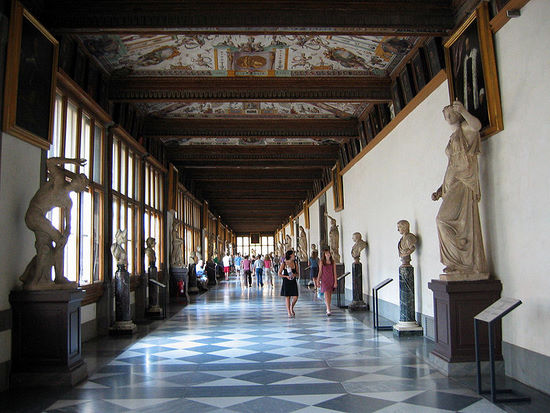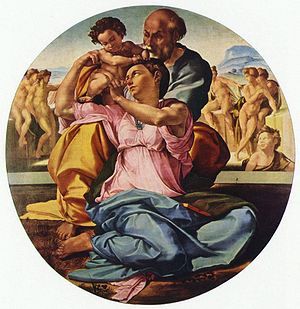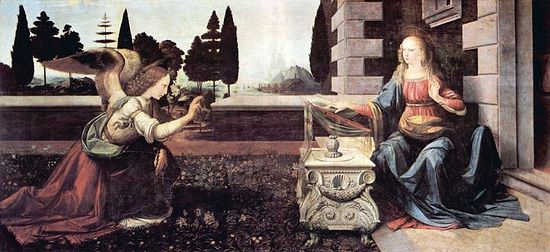Recognized as one of the most important art museums in Italy, the Uffizi Gallery in Florence is home to the works of numerous Renaissance painters, and like Paris’s Louvre, filled with more artwork than any one person can appreciate in a lifetime. Located inside a palace built in 1554, the gallery is situated in the center of Florence, the very city where much of the artwork on display was created.
 Because the Uffizi Gallery is so popular with long lines to get in, I recommend one of the following two options, 1) arrive—like I did—an hour before the museum opens (I was second in line), or, 2) pay an extra four euro and buy a reserved ticket through the Uffizi Gallery Web Site.
Because the Uffizi Gallery is so popular with long lines to get in, I recommend one of the following two options, 1) arrive—like I did—an hour before the museum opens (I was second in line), or, 2) pay an extra four euro and buy a reserved ticket through the Uffizi Gallery Web Site.
After watching the sun rise and drinking two espressos, I tromped over to the Uffizi. The museum is shaped like an “U” and has 45 numbered rooms to help you organize your visit. The museum opened at 8:15am. As I entered the Renaissance section, I was immediatly taken by the marble in the hallways and of the stunning statues, which stare out from every corner of the building, all shinning in the morning sunlight. The museum touts works by Raphael, Michelangelo, Goya, Leonardo, Caravaggio, and Botticelli—from preliminary sketches to paintings and statues, including the famous Birth of Venus, as well as lesser-known works.
 With so much to see, I had to get organized. At first, I visited the rooms in chronological order, but as they grew more and more crowded, I began skipping the most bustling rooms and, eventually, decided to skip all the way to the last room on the U-shaped corridor and work backward. I was immediately removed from the elbow bumping and it wasn’t long before I found myself face to face with Michelangelo’s only painting in Florence, Doni Tondo, in room 25. Doni Tondo is striking because of its vibrant colors, the result of a technique the Mannerist Movement proffered. Seeing the technique employed by Michelangelo, put the movement into a new perspective: The painting’s deliberate colors make it jump from the wall.
With so much to see, I had to get organized. At first, I visited the rooms in chronological order, but as they grew more and more crowded, I began skipping the most bustling rooms and, eventually, decided to skip all the way to the last room on the U-shaped corridor and work backward. I was immediately removed from the elbow bumping and it wasn’t long before I found myself face to face with Michelangelo’s only painting in Florence, Doni Tondo, in room 25. Doni Tondo is striking because of its vibrant colors, the result of a technique the Mannerist Movement proffered. Seeing the technique employed by Michelangelo, put the movement into a new perspective: The painting’s deliberate colors make it jump from the wall.
 Another memorable highlight was seeing Botticelli’s Birth of Venus. Because the painting is so often reproduced, I thought I might not be impressed. I was wrong; it is larger than life and truly unforgetable.
Another memorable highlight was seeing Botticelli’s Birth of Venus. Because the painting is so often reproduced, I thought I might not be impressed. I was wrong; it is larger than life and truly unforgetable.
My decision to work backwards through the museum was a great success until I realized that I had missed the important works of Leonardo da Vinci, found in room 15. This room was absolutely packed. Strangely, when I made my way through the crowd, there were only a few of Da Vinci’s works on display, one of which was incomplete. That combined with the fact that there were only a few works by Michelangelo and Raphael being displayed, revealed that the Uffizi is not necessarily the best museum in which to find the masterpieces of best-known Renaissance masters. The Mona Lisa, after all, is found in the Louvre.
 The Uffizi’s real beauty is that it offers the significant works of the lesser-known Renaissance masters. I’d never spent much time looking at the works of del Sarto, Titian, Caravagio, or Bronzino, and the Uffizi proudly displays their amazing talents. The Uffizi rounds out the Florentine Renaissance.
The Uffizi’s real beauty is that it offers the significant works of the lesser-known Renaissance masters. I’d never spent much time looking at the works of del Sarto, Titian, Caravagio, or Bronzino, and the Uffizi proudly displays their amazing talents. The Uffizi rounds out the Florentine Renaissance.
Finally, there is a secret passageway that runs between the Uffizi and the Medici’s Palazzo Pitti that I have heard about for years now but have never experienced. The corridor goes over the famous bridge, Ponte Vecchio, and holds more artwork. Unfortunately, it might remain a secret to many visitors because it does not operate under a set schedule, and has never been open when I’ve visited. However, ask at the ticket booth and maybe you will find it open during your visit.


Comments